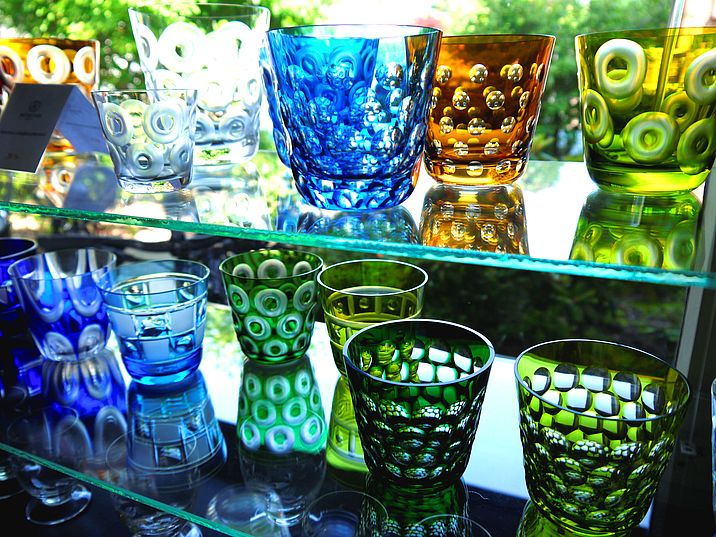News
Each glass a unique piece
Visit at Rotter Glas in Lübeck
The manufactury Rotter Glas is located in the middle of a beautiful residential area in Lübeck, between single-family houses and gardens. The manufactory would be inconspicuously integrated into the housing estate here - if the colours of the sparkling glasses were not already visible in the entrance. Like shimmering diamonds, the glasses line up next to each other, reflect the captured light and arouse our curiosity. Carl Rotter founded the company in Lübeck in 1948. After his death, his son Wolfgang Rotter took over the company and meanwhile his wife Birgit Rotter is in charge of the company. We are welcomed in the showroom; one can already hear the grinding machines working in the workshop next door.
Everywhere there are trays with colourful, still untreated glasses. Rotter Glas purchases the mouth-blown blanks from various glassworks. The pieces of jewellery are then carefully handcrafted and refined in Lübeck. Even the crystal glasses are small unique pieces, because they have different glass thicknesses. For a layman, the differences are hardly visible. However, the glass refiners must inspect each individual glass carefully, recognize the different properties and record them during their work. Before the blanks are processed, utmost care must be taken: for which of the 160 Rotter glass grindings is the cup suitable? Not every glass can be used for every decor.
Depending on the desired décor, certain grinding techniques and certain grinding stones are available. The decors are created by sanding the "overlap cups" - consisting of a clear inner and a coloured outer glass layer - by hand. The colored glass layer is sanded at the desired place so that one can see through the "exposed" clear glass. The glass receives its unmistakable special haptic and kaleidoscope-like effect. The grinding technology for this was developed by Carl Rotter in his father's company in Silesia and had the so-called ball spherical-drilling technique patented in 1929. The combination of polished and matt lines makes it easy to see that a glass was handmade. In addition, every grinder leaves his signature on the object. In this way, each piece becomes unique," explains Birgit Rotter. In order to make the glasses as similar as possible despite manual work, the pattern, number and placement of the individual elements are specified for each decor. Today, new patterns and decors are created on the computer, sometimes accidentally during work. "A deviation or a sudden inspiration sometimes leads to a completely new design. This can then develop into a whole collection. As a glass refiner, you can express your creativity and at the same time create objects for eternity," enthuses Sasha Bilgenroth about his work. The master of glass refinement has been practicing it at Rotter Glas since 1988.
Behind the Rotter Glas manufacture, however, there are not only great glass objects. Birgit Rotter and her colleagues are passionate and proud of what they do; this reflects not only the familiar working atmosphere. Zeitgeist and tradition, individuality and sustainability meet here - a concept that pays off. Passed down from generation to generation, art objects have long since become cult objects.
The timeless treasures can be viewed on the website www.rotter-glas.de or in Birgit Rotter's "Galerie der kleine Manufakturen" ARTEMANI in Lübeck. This is a platform for hand-picked manufactories and artists' studios. If you are curious and want to get an impression of where and how the coloured mugs are refined, you can also visit the Rotter Glas manufactory yourself and look over the shoulders of the glass refiners.

